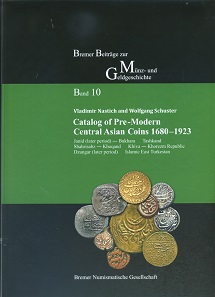by Ursula Kampmann
translated by Annika Backe
June 1, 2017 – There are areas in numismatics that are something for specialists. They have many advantages. One such advantage is that you can always buy extremely rare, interesting and valuable coins below their actual value. For the fewest dealers are specialists in all exotic areas, and so occasionally they don’t notice how rare a coin actually is, because they shun the efforts of searching the literature. The pre-monetary coins of Central Asia are such an area. The fewest coin dealers are able to read their inscriptions in the first place, or know to where and to whom they can be attributed.
Vladimir Nastich, Wolfgang Schuster, Catalog of Pre-Modern Central Asian Coins 1680-1923. Janid (later period) – Bukhara – Tashkand – Shahrisabz – Khoqand – Khiva – Khorezm Republic –
Dzungar (later period) – Islamic East Turkestan. Bremer Beiträge zur Münz- und Geldgeschichte 10. Bremer Numismatische Gesellschaft, Bremen 2017. 304 pages, color illustrations throughout, 30.4 x 21.7 cm. Hardcover. ISBN: 978-3-00-055514-5. 39 euros plus postage.
Or should we better say the fewest dealers knew to where and to which coins of Central Asia can be attributed. For as Volume 10 of its ‘Bremer Beiträge zur Münz- und Geldgeschichte’, the Bremer Numismatische Gesellschaft has published a clearly laid-out catalog that presents the coins from the territory of today’s Kazakhstan, Kyrgyzstan, Tajikistan, Turkmenistan, and Uzbekistan, minted between 1680 and 1923.
The authors are Dr. Vladimir N. Nastich, a Russian numismatist and Islamic scholar, as well as Dr. mag. Wolfgang Schuster from Austria, a well-travelled collector, who after his professional career once again studied at the Vienna Institute for Numismatics and Monetary History. Together, they have worked on this opus for more than ten years. The catalog they have written also enables anyone who can’t master Arabic to arrive at an accurate identification of the relevant coins.
The catalog covers the coins of these empires:
- Janid Khanate
- Emirate of Bukhara
- Hakimate of Tashkand
- Bekdom of Shahrisabz
- Khanate of Khoqand
- Khanate of Khiva (Khorezm)
- Khorezm People’s Soviet Republic
- Dzungar Khanate
- East Turkestan
The 20-page introductory text of the book deals with the coins of the area and provides instruction on metrology, imagery, legends and dates. The catalog proper follows next. Every chapter begins with an extremely brief historical introduction in a few sentences. Next is a list of the rulers addressed and a brief outline of the monetary system, as well as the names of the mints.
Being rich in pictures, the catalog is just the right thing for coin enthusiasts who prefer looking to reading. Every denomination is accompanied by one or more images, as well as the legend in Latin, occasionally a helpful remark and information on its rarity.
A detailed bibliography is helpful for your own research.
Basically, that’s it. The new catalog by Nastich and Schuster represents an enormous advance at any rate and is a very helpful tool for coin identification. It should become part of every coin dealership, to facilitate an accurate classification of Central Asian coins in the future. However, it’s not a substitute for your own further reading when it comes to the historical background of the coins, or your own research on the possible value of a coin. And thus the charm of the specialized area has actually been preserved, even if the correct numismatic classification of these coins might be found on the description sheet of more than one coin dealer in the future.
You can order the catalog through a contact request on the website of the Bremer Numismatische Gesellschaft e. V.
The Bremer Numismatische Gesellschaft also has a new, modern website you should have a look at. You might be interested in other publications made in Bremen, too.





